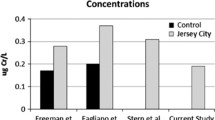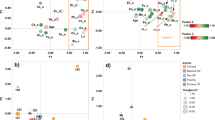Abstract
Objectives
This study is concerned with two specific chromium (Cr) exposure situations at a hard-process electroplating company. Its aims are to define variations in urinary Cr concentration and to clarify their exposure relationships.
Methods
Airborne chromium exposure and urinary excretion were measured for a-one week period. The majority of the exposed population was divided into two groups distinguishing chromium plating and polishing functions. Analysis of airborne Cr distinguished water soluble Cr(VI), water total soluble Cr and water insoluble Cr. Volunteers provided 6–7 urine samples per day for a monitoring period of 7 days.
Results
Differences between the two groups appear in relation to the type of exposure. Low concentration water soluble Cr(VI) (5.3 μg/m3 maximum) in electroplating shops is practically undetected in other workshops. Water insoluble Cr present in low concentration in electroplating exceeds 1 mg/m3 in polishing shops. Total soluble Cr concentrations are similar in these two activities (3−10 μg/m3). In polishing, 0.4% of the Cr aerosol comprises soluble Cr. Urinary Cr varied according to a 24 h cycle in similar manner in both groups throughout the monitoring week. Minimum values (3–10 μg/g crea) occurred when starting a work shift, following by a rapid rise as soon as exposure commenced, whilst maximum values (12–30 μg/g crea) were recorded towards the end of the work shift.
Conclusions
Although uncorrelated with soluble Cr(VI), urinary Cr (24 h) is effectively related to the soluble fraction of airborne chromium. In the case of chromium electroplating, correspondence between exposure and excretion appears to be governed by relationships different to those emerging from stainless steel welding, from which current biological limit values have been derived.








Similar content being viewed by others
References
American Conference of Governmental Industrial Hygienists (2006) Threshold limit values for chemical substances and physical agents: biological exposure indices. ACGIH, Cincinnati
American Conference of Governmental Industrial Hygienists (2004) Documentation of the threshold limit values and biological exposure indices: chromium(VI) water-soluble fume, recommended BEI. ACGIH, Cincinnati
Apostoli P, Maranelli G, Duca PG, Bavazzano P, Bortoli A, Cruciatti A, Elia G, Minoia C, Piccinini R, Sabbioni E, Sciarra G, Soave C (1997) Reference values of urinary chromium in Italy. Int Arch Occup Environ Health 70:173–179
Ashley K, Howe AM, Demange M, Nygren O (2003) Sampling and analysis considerations for the determination of hexavalent chromium in workplace air. J Environ Monit 5:707–716
Baruthio F (1995) Détermination du chrome, in Techniques d’analyse des oligo-éléments chez l’homme, Lavoisier ed, Paris ISBN 2. 7430–0019–8. 51–59
Benaben P (1997) Matériaux métalliques- Traitements de surface-Chromage. Techniques de l’ingénieur M-1 615:1–31
Caglieri A, Goldoni M, Acampa O, Andreoli R, Vettori MV, Corradi M, Apostoli P, Mutti A (2006) The effect of inhaled chromium on different exhaled breath condensate biomarkers among chrome plating workers. Environ Health Perspect 1144:542–546
Chen JL,Guo YL,Tsai PJ, Su LF (2002) Use of inhalableCr + 6 exposure to characterize urinary chromium concentations in plating industry workers. J Occup Health 44:46–52
De Gaudemaris R, Gary Y, Romazini S, Coudert M, Teinturier P, Grosset-Janin JP (1997) De la mesure épidémiologique à la mise en place d’une politique de prévention dans les P.M.E., exemple d’une action conduite dans les ateliers de traitement de surface de Savoie et Haute-Savoie. Arch Mal Prof 58(5):440–448
Finnish Institut of Occupational Health, Kemikaali-altistumisen Biomonitorointi [Biomonitoring of chemical exposure] Naytteenotto-ohjeet (1996) Virstan kromi,. Tyoterveyslaitos p 60
Gibb HJ, Lees PSJ, Pinski PF, Rooney BC (2000a) Lung cancer among workers in chromium chemical production. Am J Ind Med 38:115–126
Gibb HJ, Lees PSJ, Pinski PF, Rooney BC (2000b) Clinical findings of irritation among chromium chemical production workers. Am J Ind Med 38:127–131
Hoet P (1997) Chrome et ses composés. Encycl Med Chir Toxicologie-Pathologie Professionnelle 16–002-C-40, p 5
Institut National de Recherche et de Sécurité (2001) Métrologie des polluants-Évaluation de l’exposition professionnelle, Méthodes de prélèvement et d’analyse de l’air, Fiche 059 Chrome hexavalent, INRS, Paris
Institut National de recherche et de Sécurité (2004) Threshold limit values for occupational exposure to chemicals in France. ND 2098 20p, INRS, Paris
Kiilunen M (1999) Biomonitoring action levels in Finland. Int Arch Occup Environ Health 72:261–267
Kuo W, Lai JS, Lin TI (1997) Concentration and size distribution of airborne hexavalent chromium in electroplating factories. Am Ind Hyg Assoc J 58:29–32
Lin SC, Tai CC, Chan CC, Wang JD (1994) Nasal septum lesions caused by chromium exposure among chromium electroplating workers. Am J Ind Med 25:221–228
Lindberg E, Vesterberg O (1983) Monitoring exposure to chromic acid in chrome plating by measuring chromium in urine. Scand J Work Environ Health 9:333–340
Lindberg E, Hedenstierna G (1983) Chromeplating: symptoms, findings in the upper airways and effects on lung function. Arch Environ Health 38:367–374
Lindberg E, Vesterberg O (1989) Urinary excretion of chromium in chromeplaters after discontinued exposure. Am J Ind Med 16:475–492
Lorthiois M, Bouvier H, Lahaye D, Sutter B (1996) Chrome VI extractible des passivations, rapport Centre d’études techniques des industries mécaniques, no. 109 090, Cetim, Paris
Lukanova A, Toniolo P, Zhitkovitch A, Nikolova V,Panev T, Popov T, Taioli E, Costa M (1996) Occupational exposure to Cr(VI): comparison between chromium levels in lymphocytes, erythrocytes, and urine. Int Arch Occup Environ Health 69:39–44
Lumens MEGL, Ulenbelt P, Geron HMA, Herber RFM (1993) Hygienic behaviour in chromiumplating industries. Int Arch Occup Environ Health 64:509–514
Misksche LW, Lewalter J (1997) Health surveillance and biological effect monitoring for chromium exposed workers. Regul Toxicol Pharmacol 26:S94–S99
National Institute of Occupational Safety and Health (1989) Manual of analytical methods chromium, hexavalent. (Method 7 600). DHHS publication No. 84–100 Washington DC
Paustenbach DJ, Panko JM, Fredrick M, Finley BL, Proctor D (1997) Urinary chromium as a biological marker of environmental exposure: what are the limitations? Regul Toxicol Pharmacol 26:S23–S34
Pierre F, Baruthio F, Diebold F, Biette P (1995) Effect of different exposure compounds on urinary kinetics of aluminium and fluoride in industrially exposed workers. Occup Environ Med 52:396-403
Rubow KL, Marple VA, Olin J, Mc Cawley MA (1987) A personal impactor : design, evaluation and calibration. Am Ind Hyg Assoc J 48(6):532–538
Sato H, Murai K, Kanda T, Mimura R, Hiratsuka Y (2003) Association of chromium exposure with multiple primary cancers in the nasal cavity. Auris, Nasus, Larynx 30:93–96
SheehanP, Ricks R, Ripple S, Paustenbach D (1992) Field evaluation of a sampling and analytical method for environmental levels of airborne hexavalent chromium. Am Ind Hyg Assoc J 53:57–68
Sorahan T, Harrington JM, (2000) Lung cancer in Yorkshire chrome platers, 1972–97. Occup Environ Med 57(6):385–389
Sutter B (1997) Chrome VI extractible des passivations. CETIM-Informations, Cetim, Paris, 152:55–56
Acknowledgments
The authors wish to thank Marie-Thérèse Brondeau for her invaluable help in proofreading the manuscript, and Patrick Biette, Geneviève Hubert, Richard Wrobel, Anne-Marie Lambert and Martine Roussel for their technical assistance.
Author information
Authors and Affiliations
Corresponding author
Rights and permissions
About this article
Cite this article
Pierre, F., Diebold, F. & Baruthio, F. Biomonitoring of two types of chromium exposure in an electroplating shop. Int Arch Occup Environ Health 81, 321–329 (2008). https://doi.org/10.1007/s00420-007-0216-x
Received:
Accepted:
Published:
Issue Date:
DOI: https://doi.org/10.1007/s00420-007-0216-x




